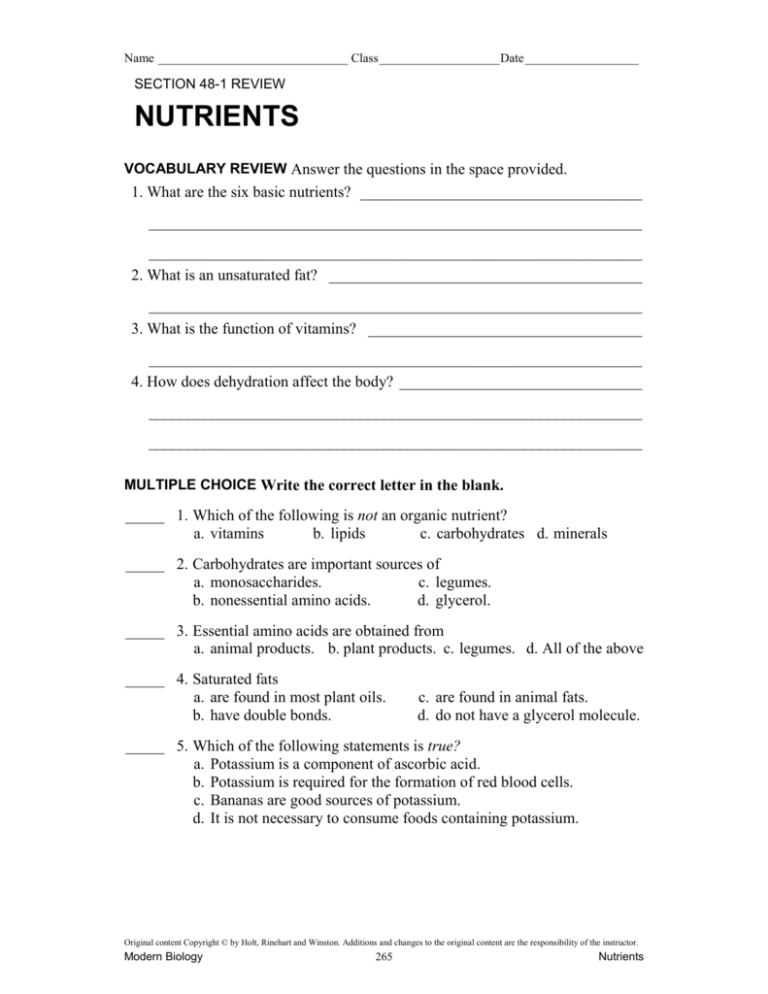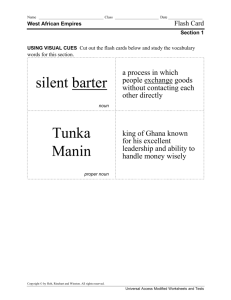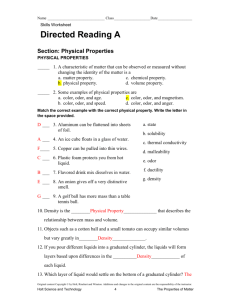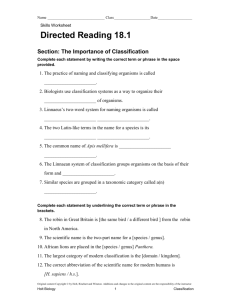files/Ch 48 Study Guide
advertisement

Name ______________________________ Class ___________________ Date __________________ SECTION 48-1 REVIEW NUTRIENTS VOCABULARY REVIEW Answer the questions in the space provided. 1. What are the six basic nutrients? ____________________________________ _______________________________________________________________ _______________________________________________________________ 2. What is an unsaturated fat? ________________________________________ _______________________________________________________________ 3. What is the function of vitamins? ___________________________________ _______________________________________________________________ 4. How does dehydration affect the body? _______________________________ _______________________________________________________________ _______________________________________________________________ MULTIPLE CHOICE Write the correct letter in the blank. _____ 1. Which of the following is not an organic nutrient? a. vitamins b. lipids c. carbohydrates d. minerals _____ 2. Carbohydrates are important sources of a. monosaccharides. c. legumes. b. nonessential amino acids. d. glycerol. _____ 3. Essential amino acids are obtained from a. animal products. b. plant products. c. legumes. d. All of the above _____ 4. Saturated fats a. are found in most plant oils. b. have double bonds. c. are found in animal fats. d. do not have a glycerol molecule. _____ 5. Which of the following statements is true? a. Potassium is a component of ascorbic acid. b. Potassium is required for the formation of red blood cells. c. Bananas are good sources of potassium. d. It is not necessary to consume foods containing potassium. Original content Copyright © by Holt, Rinehart and Winston. Additions and changes to the original content are the responsibility of the instructor. Modern Biology 265 Nutrients Name ______________________________ Class ___________________ Date __________________ SHORT ANSWER Answer the questions in the space provided. 1. Explain the difference between essential amino acids and nonessential amino acids. __________________________________________________________ _______________________________________________________________ _______________________________________________________________ 2. Describe the importance of simple sugars for normal body functioning. _______________________________________________________________ _______________________________________________________________ _______________________________________________________________ 3. List two reasons that water is an important nutrient. _____________________ _______________________________________________________________ 4. Critical Thinking What characteristic is common to all of the nutrients? _______________________________________________________________ _______________________________________________________________ _______________________________________________________________ STRUCTURES AND FUNCTIONS Use the food pyramid below to answer the following questions. 1. Based on the organization of the pyramid, which food group does the body need and use the most? What is the primary nutrient in this group? _________ ________________________________________________________________ 2. Which food group contains all of the essential amino acids? Is this the only group that contains essential amino acids? Explain your answer. ___________ ________________________________________________________________ Original content Copyright © by Holt, Rinehart and Winston. Additions and changes to the original content are the responsibility of the instructor. Modern Biology 266 Nutrients Name ______________________________ Class ___________________ Date __________________ SECTION 48-2 REVIEW DIGESTIVE SYSTEM VOCABULARY REVIEW Explain the relationship between the terms in each of the following pairs of terms. 1. pharynx, epiglottis _______________________________________________ _______________________________________________________________ 2. ulcer, gastric fluid ________________________________________________ _______________________________________________________________ 3. peristalsis, colon _________________________________________________ _______________________________________________________________ 4. pyloric sphincter, chyme __________________________________________ _______________________________________________________________ 5. villus, gastrointestinal tract _________________________________________ _______________________________________________________________ MULTIPLE CHOICE Write the correct letter in the blank. _____ 1. The gastrointestinal tract includes the a. liver. b.large intestine. c. pancreas. d. All of the above _____ 2. Bile is a. released into the small intestine. c. stored in the gallbladder. b. produced by the liver. d. All of the above _____ 3. Chemical digestion involves a. the molars. b. saliva. c. the hard palate. d. the incisors. _____ 4. Which of the following is a component of both the respiratory system and the digestive system? a. esophagus b. salivary glands c. pharynx d. peristalsis _____ 5. Ulcers are linked to breakdown of the a. pyloric sphincter. c. stomach lining. b. gallbladder function. d. common bile duct. Original content Copyright © by Holt, Rinehart and Winston. Additions and changes to the original content are the responsibility of the instructor. Modern Biology 267 Digestive System Name ______________________________ Class ___________________ Date __________________ SHORT ANSWER Answer the questions in the space provided. 1. What is the function of mucus in the stomach? _________________________ _______________________________________________________________ 2. What is the primary role of pepsin in digestion? ________________________ _______________________________________________________________ 3. How does the pancreas aid digestion? ________________________________ _______________________________________________________________ 4. Critical Thinking Which part of the gastrointestinal tract should have the highest concentration of blood capillaries? Explain your answer. ___________ _______________________________________________________________ _______________________________________________________________ STRUCTURES AND FUNCTIONS Use the figure of the gastrointestinal tract below to answer the following questions. 1. Label each part of the figure in the spaces provided. 2. Which organ is not part of the gastrointestinal tract? How does this organ aid digestion? _______________________________________________________________ _______________________________________________________________ 3. In which organ does absorption take place? What structural features make this organ particularly well-suited for absorption of nutrients into the blood? _____ _______________________________________________________________ _______________________________________________________________ Original content Copyright © by Holt, Rinehart and Winston. Additions and changes to the original content are the responsibility of the instructor. Modern Biology 268 Digestive System Name ______________________________ Class ___________________ Date __________________ SECTION 48-3 REVIEW URINARY SYSTEM VOCABULARY REVIEW Define the following terms. 1. nephron ________________________________________________________ _______________________________________________________________ 2. urethra _________________________________________________________ _______________________________________________________________ 3. renal medulla ___________________________________________________ _______________________________________________________________ 4. excretion _______________________________________________________ _______________________________________________________________ 5. urea ___________________________________________________________ _______________________________________________________________ MULTIPLE CHOICE Write the correct letter in the blank. _____ 1. Most reabsorption within a nephron occurs in the a. Bowman’s capsule. c. collecting duct. b. duodenum. d. proximal convoluted tubule. _____ 2. Which of the following is not part of the nephron? a. glomerulus b. loop of Henle c. ureter d. Bowman’s capsule _____ 3. Which of the following substances would not normally be collected in the Bowman’s capsule? a. small proteins b. glucose c. erythrocytes d. vitamins _____ 4. The renal pelvis a. empties into the renal vein. b. is an extension of the ureter. c. is a part of the nephron. d. All of the above _____ 5. During the process of reabsorption, components of the filtrate are a. actively transported out of the nephron. b. transferred to the capillaries surrounding the nephron. c. separated from waste products. d. All of the above Modern Biology Study Guide 269 Name ______________________________ Class ___________________ Date __________________ SHORT ANSWER Answer the questions in the space provided. 1. Describe the importance of filtration in urine production. _________________ _______________________________________________________________ 2. How do the kidneys contribute to homeostasis? ________________________ _______________________________________________________________ 3. Why are nephrons considered the structural and functional units of the kidney? ___________________ _______________________________________________________________ _______________________________________________________________ 4. Critical Thinking How is ammonia related to kidney functioning? _______________________________________________________________ _______________________________________________________________ _______________________________________________________________ STRUCTURES AND FUNCTIONS Use the figure of a nephron and the information below to answer the following questions. About 99 of every 100 mL of filtrate are reabsorbed into the blood, and about 1,500 mL (1.6 qt) of urine are excreted per day. 1. Label each part of the figure in the spaces provided. 2. In which structure is the filtrate collected? ____________________________ 3. Based on the amount of urine excreted daily, about how many milliliters of filtrate would be produced daily by a pair of normally functioning kidneys? ____________________________________________ Original content Copyright © by Holt, Rinehart and Winston. Additions and changes to the original content are the responsibility of the instructor. Modern Biology 270 Digestive System








